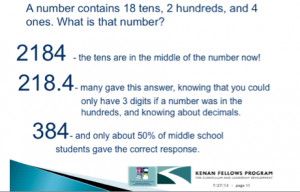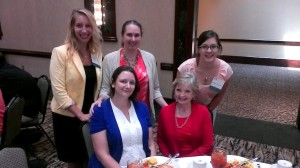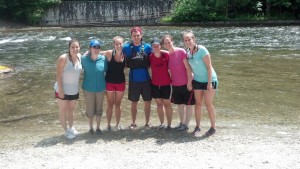The above slide is from our DPI Kenan Project. These are results from Grayson Wheatley’s survey of 5,000 middle school students. Only 1/2 of the students could correctly answer this place value question. Mathematics Researcher Kathy Richardson says, “if your students are having problems in algebra, fix it in K-2.” This viewpoint has been the foundation of our work.
I have to say my biggest A-HA is how well our project group gels. From our relationship with our mentor, Barbara, to the team dynamic among Alex, Christina, and myself, everything just works. Honestly, I went into the experience a little concerned about how four driven, strong-willed women might be a clash of minds/opinions. However, it’s been incredible to see what we are creating together. We have a common concern for the climate of mathematics education and assessment in our schools, and more importantly, we share a common vision on how we can impact change. Even though we have different opinions on project aspects (and may I add, great educational discussions around those differences) we come together and find ways to collaborate purposefully around our shared vision. I think this is the key to making our project tick.
My next A-HA is that while everyone seems to be talking about the wrap-up of their externships, we are just really beginning. Don’t get me wrong, we have done a lot of work and have laid our framework, but the busiest part of our fellowship will be during this school year. So much of our DPI expectations revolve around actual student use of the formative assessments we are working on, and another part is talking to district leads, teachers, and researchers about these assessments. So, ready, set, go, our team is about to start new school years and go full tilt on our project!


